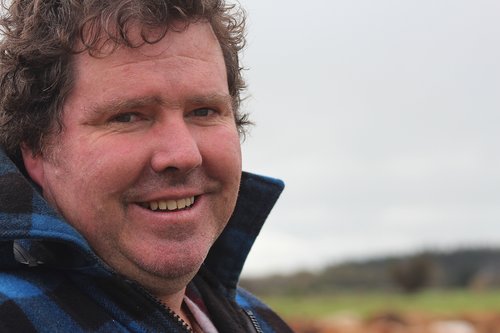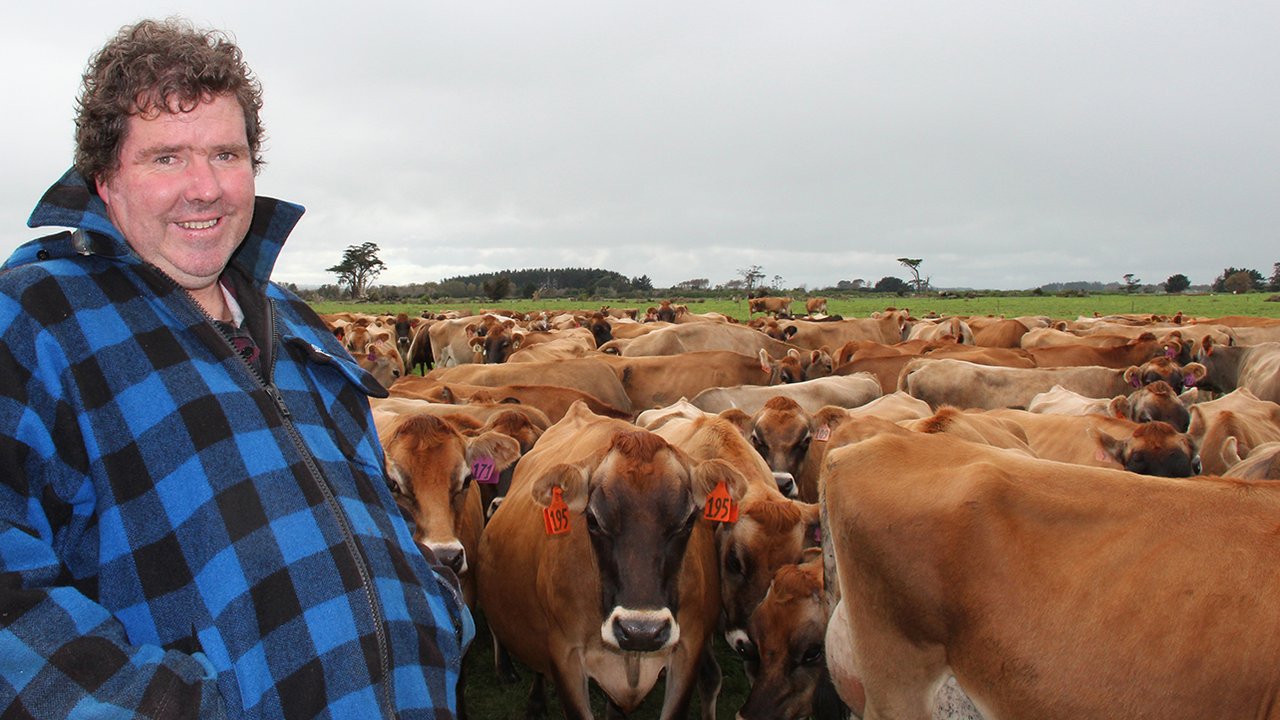 Dave Gibson of Kapuni says LIC's Sire Proving Farmer of the Year accolade came as a “pleasant surprise” -- but several key observers in the industry believe the award was inevitable.
Dave Gibson of Kapuni says LIC's Sire Proving Farmer of the Year accolade came as a “pleasant surprise” -- but several key observers in the industry believe the award was inevitable.
Among the most-qualified of observers is LIC sire acquisition manager Casey Inverarity, who visited Dave’s herd during autumn.
“I visited his farm because he has a contract cow with us – it’s an exceptional cow. I realised Dave was running a sire proving herd so I looked through some of the daughters of young bulls we know well.
“I took with me a prominent local breeder, Rob Thwaites of Glanton Stud (in nearby Opunake). Rob has several bulls close to, or in the shadow Premier Sires Jersey team, and he was keen to see some of the daughters, and they really were brilliant.
“While we were there Dave had drafted out some of his cows and they really were exceptional, outstanding, animals. I’ll be seeking to do another walk-through the herd and I’ll be taking some more breeders with me.”
Proof of the pudding
Four of Dave’s cows were professionally photographed to feature in LIC’s 2018 Alpha catalogue.
In terms of Breeding Worth (BW), Dave’s herd is among the top five percent in the country.
This perhaps reflects the quality and consistency of Dave's culling decisions over the years, his attention to herd recording, and his confidence in herd testing information.
Dave says the quality of young bulls mated to his herd since he joined the Sire Proving Scheme (SPS) in 2009 has also played a significant role in maintaining his BW in the top five-percent.
“Back in 2009 my former wife was working for LIC and we thought there was a lot going on with DNA genomic-selection technology.
“We thought the quality of (yet-to-be-proven) bulls should be quite good, and although it got off to a rocky start we thought it would improve as time went on. The genomic offering appealed because we thought it presented an opportunity for access to better genetics at a low cost with SPS.”
A good mix of ingredients
There's a degree of flexibility in SPS, allowing Dave to nominate up to 10% of his cows to bulls, and in several recent seasons he’s sought the advice of an LIC sire acquisition manager to do so.
Dave says his herd was previously owned by his father, Tom, a former LIC director. Dave purchased the 280-strong herd from his father in 1992 when the family farm was located down the road at Auroa.
In the 1990s, the herd was the top Breeding Index (the fore-runner to BW) mob in the country.
By 1999, the index had changed to BW, and herd was still rated number one – that was the same year Dave moved to his current 67 ha Skeet Rd property, and he reduced herd numbers to 200.
Benefits of belonging to SPS
Dave says being part of the Sire Proving Scheme is rewarding, and the relatively low cost of quality genetics is a big carrot, but there are widespread benefits about a disciplined approach in bringing through young stock.
Asure Quality weighs replacement stock as they simultaneously get conditioned-scored, and LIC pays for the sire verification of all heifer calves, Dave says.
“We’d DNA verify them anyway, so it’s bonus for me. LIC also forwards a rebate for the heifers’ herd tests in their first year.”
Dave herd tests five times a year. “We like to have the data; we like to see how they’re producing at different times and it’s good to have a more accurate picture of what the cow’s doing throughout the season – I’m always interested. If they’re not any good, they get culled.”
Seeking solid milkers; seeking milksolids
 The most significant trait Dave seeks in his genetics centres on the udders.
The most significant trait Dave seeks in his genetics centres on the udders.
“I’m looking for animals that are easy-to-calve and which do decent production and milksolids, but for me it’s the udder that’s really important.
“This herd’s udders are pretty tidy. I’ve got maybe two in there that might be starting to get a bit long, you know – losing their support.
“Sometimes you’ll get a heifer after calving and the cups won’t stay on them, you have to hold on to them for a bit and it’s frustrating when you’re busy. If the rear teats are a bit far back it’ll suck the air until it’s milked the tension out the udder.”
Traditionally the herd has produced about 450kg milksolids (MS) per cow, sometimes up to 470kg. More recently however, due to a new feed system inside the 20-aside herringbone (equipped with Protrack ID Herringbone), Dave has been able to increase production.
He was hoping to end up at 500kg MS/cow by season-end for 2017/2018, with a view to doing the same the 2018/2019 season.
“We’ve fed a bit of palm kernel and they’ve milked so much better. Fonterra will start grading shortly but we should be able to manage without being penalised, especially if the grass continues to grow.”





